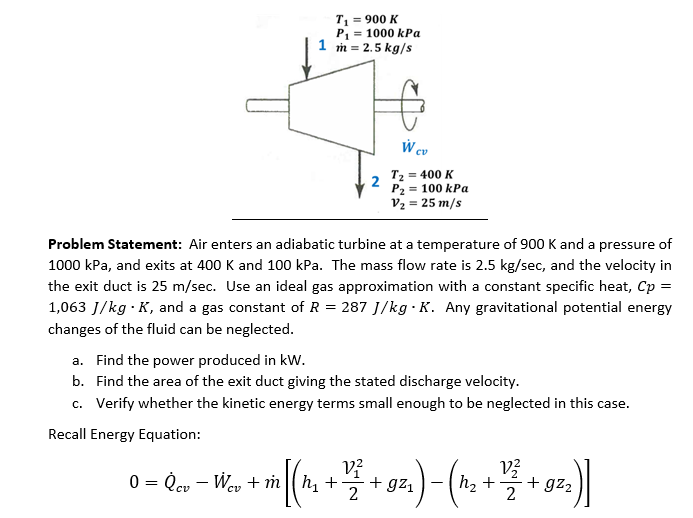T1 = 900 K P1 = 1000 kPa 1 m = 2.5 kg/s W co T2 = 400 K 2 P2 = 100 kPa v2 = 25 m/s Problem Statement: Air enters an adiabatic turbine at a temperature of 900 K and a pressure of 1000 kPa, and exits at 400 K and 100 kPa. The mass flow rate is 2.5 kg/sec, and the velocity in the exit duct is 25 m/sec. Use an ideal gas approximation with a constant specific heat, Cp = 1,063 J/kg · K, and a gas constant of R = 287 J/kg · K. Any gravitational potential energy changes of the fluid can be neglected. a. Find the power produced in kW. b. Find the area of the exit duct giving the stated discharge velocity. c. Verify whether the kinetic energy terms small enough to be neglected in this case. Recall Energy Equation: v? 0 = Qcv – Wey + m|(h, + + gz1 h2 + + gz2
T1 = 900 K P1 = 1000 kPa 1 m = 2.5 kg/s W co T2 = 400 K 2 P2 = 100 kPa v2 = 25 m/s Problem Statement: Air enters an adiabatic turbine at a temperature of 900 K and a pressure of 1000 kPa, and exits at 400 K and 100 kPa. The mass flow rate is 2.5 kg/sec, and the velocity in the exit duct is 25 m/sec. Use an ideal gas approximation with a constant specific heat, Cp = 1,063 J/kg · K, and a gas constant of R = 287 J/kg · K. Any gravitational potential energy changes of the fluid can be neglected. a. Find the power produced in kW. b. Find the area of the exit duct giving the stated discharge velocity. c. Verify whether the kinetic energy terms small enough to be neglected in this case. Recall Energy Equation: v? 0 = Qcv – Wey + m|(h, + + gz1 h2 + + gz2
Elements Of Electromagnetics
7th Edition
ISBN:9780190698614
Author:Sadiku, Matthew N. O.
Publisher:Sadiku, Matthew N. O.
ChapterMA: Math Assessment
Section: Chapter Questions
Problem 1.1MA
Related questions
Question

Transcribed Image Text:T1 = 900 K
P1 = 1000 kPa
1 m = 2.5 kg/s
W co
T2 = 400 K
2
P2 = 100 kPa
v2 = 25 m/s
Problem Statement: Air enters an adiabatic turbine at a temperature of 900 K and a pressure of
1000 kPa, and exits at 400 K and 100 kPa. The mass flow rate is 2.5 kg/sec, and the velocity in
the exit duct is 25 m/sec. Use an ideal gas approximation with a constant specific heat, Cp =
1,063 J/kg · K, and a gas constant of R = 287 J/kg · K. Any gravitational potential energy
changes of the fluid can be neglected.
a. Find the power produced in kW.
b. Find the area of the exit duct giving the stated discharge velocity.
c. Verify whether the kinetic energy terms small enough to be neglected in this case.
Recall Energy Equation:
v?
0 = Qcv – Wey + m|(h, +
+ gz1
h2 +
+ gz2
Expert Solution
This question has been solved!
Explore an expertly crafted, step-by-step solution for a thorough understanding of key concepts.
This is a popular solution!
Trending now
This is a popular solution!
Step by step
Solved in 6 steps with 8 images

Recommended textbooks for you

Elements Of Electromagnetics
Mechanical Engineering
ISBN:
9780190698614
Author:
Sadiku, Matthew N. O.
Publisher:
Oxford University Press

Mechanics of Materials (10th Edition)
Mechanical Engineering
ISBN:
9780134319650
Author:
Russell C. Hibbeler
Publisher:
PEARSON

Thermodynamics: An Engineering Approach
Mechanical Engineering
ISBN:
9781259822674
Author:
Yunus A. Cengel Dr., Michael A. Boles
Publisher:
McGraw-Hill Education

Elements Of Electromagnetics
Mechanical Engineering
ISBN:
9780190698614
Author:
Sadiku, Matthew N. O.
Publisher:
Oxford University Press

Mechanics of Materials (10th Edition)
Mechanical Engineering
ISBN:
9780134319650
Author:
Russell C. Hibbeler
Publisher:
PEARSON

Thermodynamics: An Engineering Approach
Mechanical Engineering
ISBN:
9781259822674
Author:
Yunus A. Cengel Dr., Michael A. Boles
Publisher:
McGraw-Hill Education

Control Systems Engineering
Mechanical Engineering
ISBN:
9781118170519
Author:
Norman S. Nise
Publisher:
WILEY

Mechanics of Materials (MindTap Course List)
Mechanical Engineering
ISBN:
9781337093347
Author:
Barry J. Goodno, James M. Gere
Publisher:
Cengage Learning

Engineering Mechanics: Statics
Mechanical Engineering
ISBN:
9781118807330
Author:
James L. Meriam, L. G. Kraige, J. N. Bolton
Publisher:
WILEY